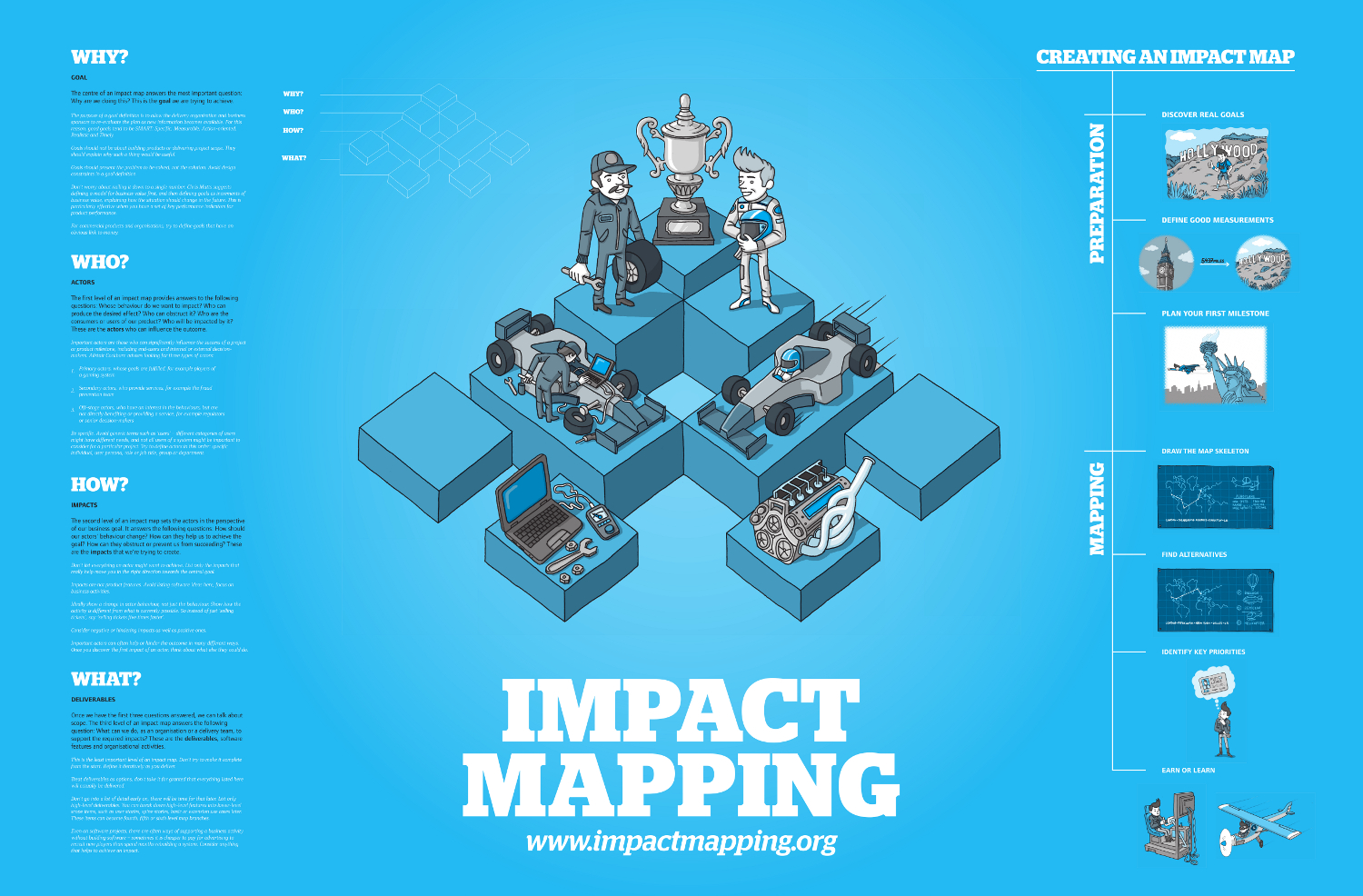Introduction to Impact Mapping – Impact Map for an eCommerce Product
leenaFebruary 26, 2016
- The single biggest problem in communication is the illusion that it has taken place - Bernard Shaw*
According to the Standish CHAOS report, only ~30% of software projects succeed. Others end up either being in a “challenged” state or fail altogether because of various reasons such as over budget, over time or lack of alignment. Let us look at some of the case studies.

[The modern resolution (OnTime, OnBudget, with a satisfactory result) of all software projects from FY2011-2015 within the new CHAOS database.]
Credit: http://www.infoq.com/articles/standish-chaos-2015
“After nine years of work and billions of pounds already spent, the UK government recently abandoned a doomed IT project because ‘it wasn't essential.
"Commercial organisations across the European Union lost 142 billion EUR on failed IT projects in 2004 alone, mostly because of poor alignment with business objectives or business strategies becoming obsolete during delivery. This is roughly the cost of the International Space Station programme, including all flights, or almost twice the cost of the entire Apollo programme, which achieved six manned landings on the Moon.”
[Excerpt from the Impact Mapping book]
Strategic Alignment
 .
.
[Credit: http://image.slidesharecdn.com/21centurysoftware-130830104432-phpapp02/95/21-century-software-6-638.jpg?cb=1423023399].
It is common to see this model called the Water-Scrum-Fall model, where:
-
HIPPO [the Highest Paid Person in the room] decides the backlog
-
The dev team work towards the same in the so-called "iterative" way
-
The OPs fire starts because the products aligns with the market
Some teams try to solve this problem of with the project charter or vision document but visibility becomes a struggle as these documents exists in some repository, hardly known to anyone or updated by anyone.
Ask your team members: “What is the goal of your project?”. You may be surprised to know how many actually know about it.
Another issue is that even though the Product Manager/Product Owner or the stakeholder has clarity on the “strategy” or “vision”, there is no forum to converse about these among the team.
The planning meetings [iteration or release planning] are supposed to be taking care of this. But lack of clear guidelines for these planning meetings, results in backlog of features which are prioritised using:
-
Ad-hoc planning
-
Wrong Assumptions
-
Pet features
Impact Mapping

Credit: http://www.impactmapping.org/assets/poster_im_print_1500.jpg
Impact Mapping is a "Strategic planning technique",explained in the book Impact Mapping by Gojko Adzic.
-
Software delivery can’t be done in a vacuum by the technical team instead, it is a collaborative effort between the end users, the business team and the technical team.
-
The dynamic nature of software, adds to the complexity too.
So what is required, is a “technique” which:
-
Focuses on collaboration among all the stakeholders
-
Visualises and communicates the assumptions clearly
-
Is fast and iterative so that changes can be adapted without delay
An “Impact Map” is a “mindmap”, derived from the discussion where all the stakeholders, both technical and business people, are involved. It mainly answers the below four questions:
-
Why?
-
Who?
-
What?
-
How?
Let’s look at Impact Mapping in detail, taking an eCommerce product as an example.
Why?
Gary Klein, a research psychologist famous in the field of naturalistic decision making,says that, to take better decisions during unforeseen events people should know the purpose of doing something. The research was done on emergency professionals which include firefighters, critical care nurses, pilots, nuclear power plant operators, battle planners, and chess masters to see how they make decisions in split seconds.
This is the reason “Why” is the center of the Impact Map. It all starts with the question.
This should be the milestone that the entire team tries to achieve.
It is common for teams to have a roadmap of features, which are added either by the Stakeholders or by the team members themselves. A good technique is to use the5 Whys techniqueto see why the feature is required and then arrive at a goal.
Example
Let us do that for an eCommerce project. Assume the roadmap contains Introduce Social Sharing and let’s do a 5 Whys for the same:
Q: “Why Social Sharing?”
A: “So that they can share their transactions with their friends in Twitter or Facebook”
Q: “Why Should they share with friends?”
A: “So that more people visit the site”
Q: “Why more people should come to the site?”
A: “To buy more products”
Q: “Why?”
A: “To increase the transaction volume”
Q: “Oh ok, so the goal is to increase the transaction volume. What should be the next immediate target? “
A: “Immediate target should be to reach out to 1 M transaction within the next 3 months.”
Once you find out the goal [Increase the transaction volume], we need to identify the milestone [ 1M transactions within next 3 months] and that becomes the center of the Impact map.

Getting it Right
Good goals need to be SMARTi.e. Specific, Measurable, Achievable, Realistic and Timely. Explain why it's valuable instead of placing it around the features or scope.
Who?
The “who” is the first level of Impact Map, these are the actors who can influence the product.
According to Gerald Weinberg,an American computer scientist, author and teacher of the psychology and anthropology of computer software development,.
And for us to deliver value, we need to understand who they are and what kind of value or outcome they are looking from the product. We also need to consider others whose decisions can influence the success of the product.
You should ask the below questions to identify the actors:
-
Who can produce the desired effect?
-
Who can obstruct it?
-
Who are consumers of the product?
-
Who will be impacted with it?
Example
Let’s look at it from the perspective of our product i.e. eCommerce product:
-
Shoppers who buy products
-
Product Vendors whose products get sold
-
Payment Gateway Provider(s) whose services will be used for the payment
-
Support Personnel who handle the shoppers’ queries
-
Admin Personnel, who manages the catalogue

Getting it Right
Rather than the generic term “users”, it is recommended to identifyPersonasfor each of the actors [with their demographics such as name, job title, age]. This should help everyone in the team to empathise with the actors.
How?
The second level of the Impact Map is to identify the impact that we are going to create on the users i.e what changes are we looking at the actors’ behavior. AsAnthony W. Ulwick mentioned,success delivery of any product or service is to understand what customers want instead of delivering what customers ask for. Every impact should result in behavior change of the users.
Some of the questions that need to be answered to understand the impact are:
-
How should the goal change the actors’ behavior?
-
How can actors’ help us in achieving the goal?
-
How can actors’ prevent us from achieving the goal?
Example
What kind of impact should be provided to achieve the goal 1 M transactions? How can the actors help us or prevent us from achieving the same?
-
Improved product discovery
-
Allow the Vendors to add the products without help from Admin Staff
-
Inviting Friends
-
90% of payments being successful
-
All support tickets closed in 24 hours

Getting it Right
Impacts are not product features. Focus on the activities rather than the product ideas. Focus on the actual behavior change, highlight how it’s different than what they are doing right now. Once you identify the first impact for an actor, think about what else they could do. This would help us to plan and prioritise better.
Consider both negative or hindering impacts along with the positive ones.
What?
This is the last level of Impact Mapping. The question to be asked in this section is “What can be done to bring in the impact we are looking for?” These are the deliverables, the software features and organisational activities. An impact map puts these deliverables in the context of the impacts that the team is supposed to support. With this clear hierarchy, the team can plan and prioritise deliverables, by grouping the related deliverables and avoid investing in less important ones.
This section concentrates on the deliverables or features which will create the desired impact on the actors. After identifying the deliverables, the team prioritises them to fit in into the timeline. This way Impact Map helps the team to slice the goals into smaller independent chunks so that the value can be delivered faster in smaller iterations.
Examples
-
Improve the search algorithm
-
Simple and intuitive search UI
-
Provide options for Social sharing
-
Admin Console for Vendors to manage products
-
Move to a reliable Payment Gateway, to improve the user experience
-
Facebook Ads or Google Ads for branding
-
Better alerting mechanisms for failed payments

Getting it Right
This is the least important part of the impact map, so don’t try to get it right, instead, refine iteratively as you deliver. At times some impacts can be achieved without building software, eg: investing in marketing or branding too can help adding more users into the system without building many features.
“Never aim to implement the whole map, instead find the shortest path through the map to the goal.” - Gojko Adzic
Earn or Learn
One key thing about Impact Mapping is the concept of “Earn or Learn” i.e. whether the goal is to increase revenue or is to learn about the market. This is very important to keep in mind while answering “Why” of Impact Map. It is recommended to keep the duration short if the goal is “learn”, to avoid investing a lot of money and effort. Ideal experiments can be for a few days to few weeks, and the Lean Startup way of “Build Measure Learn” is highly recommended for “learning” faster.
It is an illusion to assume that our deliverables are perfect and will give us our results that we expected. Have objectively measurable metrics for every business goal and look at it on a very frequent basis [daily and weekly] during the entire duration of the goal. With Impact Map conveying the goals clearly, it helps to bring the team back to track and also to a great extent avoid the trap of just sticking to the plan or implementing features randomly.
Mind mapping tools
There are quite a few online mind mapping tools that are available. Some tools I would recommend are MindMup, Coggle.It, MindMeister.
A note on MindMup, it’s a tool designed by Gojko Adzic himself for creating the Impact Maps.
Conclusion
If you closely look at Impact Mapping, it is based on the concept of “Asking the right questions to identify the right problems”, which is well aligned with Lean Management. This helps for embracing the Lean startup way of Build-Measure-Learn or Plan-Do-Check-Act Cycle[also known as PDCA cycle or Deming Cycle] for delivering software.
